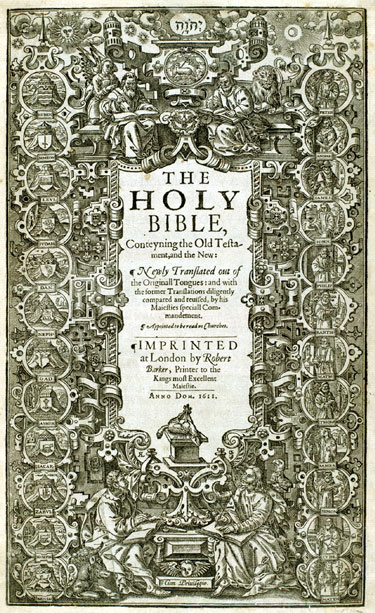
Probably the most influential–and most printed–book, the Authorized King James Bible (KJV) is 400 this year. There are scads of new popular and scholarly articles and books commemorating this anniversary being published this year. To see the real thing, come by Special Collections to see the first KJV, printed by Robert Barker in 1611. Call number BS 170 1611X
To read more about it, here’s the New York Times article about the KJV at 400 by Pomona College alum Verlyn Klinkenborg.
New Exhibition: Dark Materials, Knowledge in the Seventeenth Century
Dark Materials, Knowledge in the Seventeenth Century. Honnold/Mudd Library, 2nd floor near north entrance. Dec 1, 2010-Feb 25, 2011.
John Milton (1608-1674) was not only among the most influential of British poets. He was the most directly involved of any British poet in the centers of political power and in the great historical events of the 17th century in Britain. He was also arguably the most learned of the great British poets, even in a learned and bookish century.
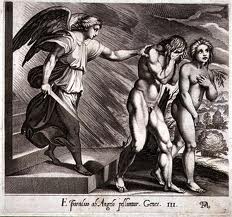
This exhibition, drawn from the collections of Special Collections, Honnold Library, and Denison Library of Scripps College, focuses on our holdings of Milton’s most famous work, his epic, Paradise Lost, first issued in 1667, and on books and pamphlets written by his contemporaries who were espousing ideas of religion, nature, science, politics, and philosophy during this turbulent century.
The exhibit was mounted to coincide with the Milton Marathon of 2010. Many thanks to professors Jacque Wernimont of Scripps College and Colleen Rosenfeld of Pomona College who hatched a fantastic plan to read Paradise Lost all day.
Dec 1, 2010 at 7 p.m.: “How Milton Sounds” talk by Jeff Dolven of Princeton University. Dec 2, 2010 at 8 a.m. – 8 p.m. Milton Marathon, Mudd Quad outside the north entrance of Honnold Library.
Come by and read and/or listen to friends and colleagues read Paradise Lost. There’ll be refreshments!
Recent Gift: Audubon prints
Special Collections recently received a gift of 31 19th century prints. Among the items in the gift are thirteen original John James Audubon hand-colored lithographs (20 1/2 in. x 26 1/2 in.) from the quadruped series, including the American Badger (pictured below) and Common Flying Squirrel.
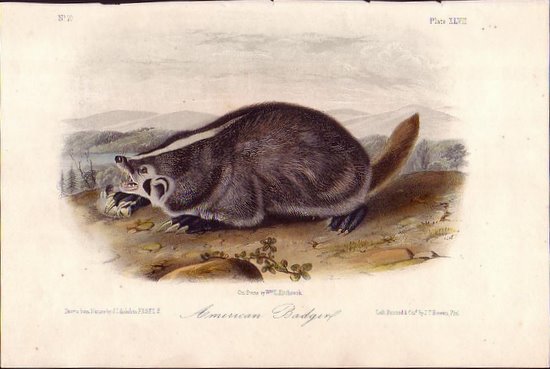
Eleven prints are chromolithographs (16 1/2 in. x 21 1/2 in.) from the Bien edition of Audubon’s Birds of America (ca. 1858-1862), including Puffin:
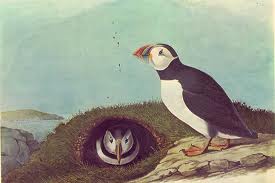
These prints are amazing examples of early and mid 19th century printing. When the Bien edition of Audubon’s Birds was being produced, chromolithography was new, and Julius Bien of New York was a pioneer in this technique of color printing.
New exhibit: Memory Keepers
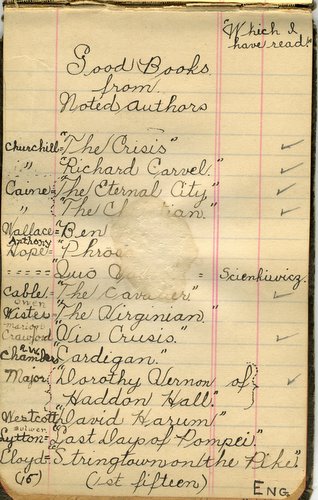
John Myers’ travel journal, from Ohio to San Francisco. Memory Keepers. September 16, 2010-November 5, 2010. Honnold/Mudd Library.
The focus of this exhibition is personal diaries and journals, some of the unique primary sources Special Collections is privileged to collect and preserve for research and teaching. Each diary selected reflects the events, the mood, and the perception of reality experienced by the writers and bear historical witness to what life was like during particular periods.
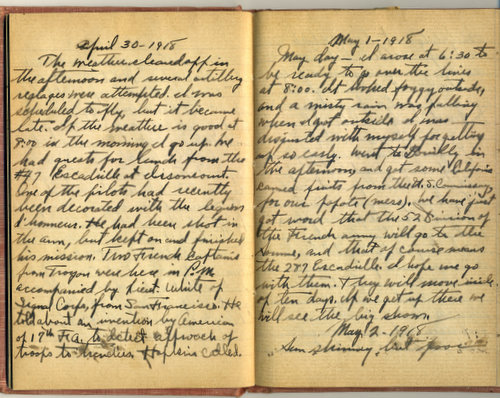
H.T. Douglas’ Personal Journal of World War I
The diaries and journals on view are from our holdings of personal papers and family archives, company records, Colleges’ archives, and other manuscript collections. These collections contain rich personal stories of China in the early 20th century, the American Civil War, gold fields of Alaska, travels in 19th century America, Victorian theater, and other historical moments and events.
FMI: Special Collections, 909-607-3977 and spcoll@cuc.claremont.edu
Welcome students!
Welcome to the class of 2014 and welcome back our returning students! As you settle in, here are some images of dorm life from the Claremont Colleges Photo Archive in the Claremont Colleges Digital Library (CCDL). Enjoy!
Scripps ca. 1960s
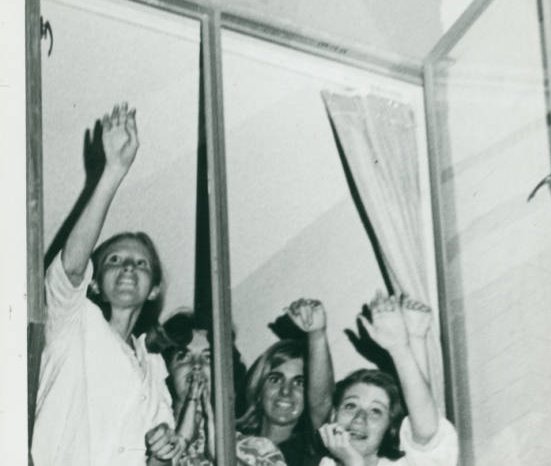
CMC ca 1960s
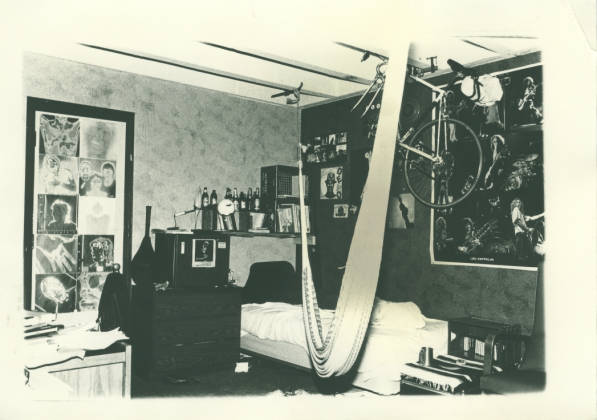
HMC, ca 1950s
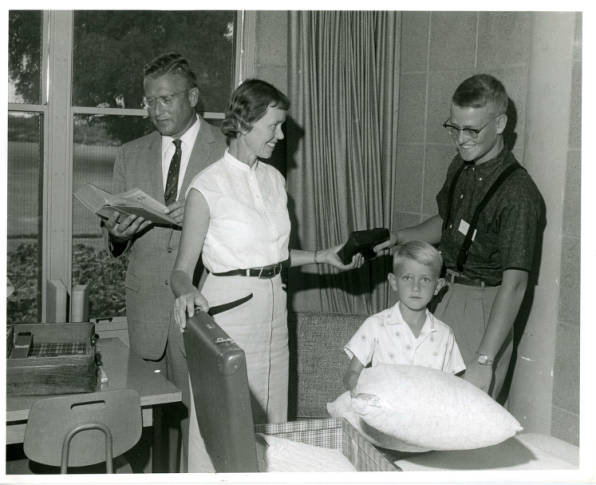
Pomona, 1904
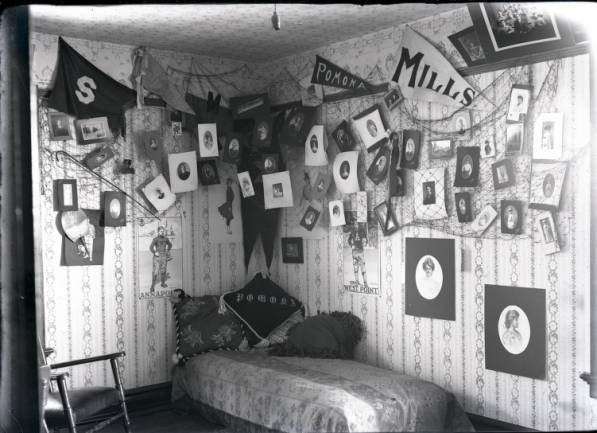
Pitzer, ca 1970s
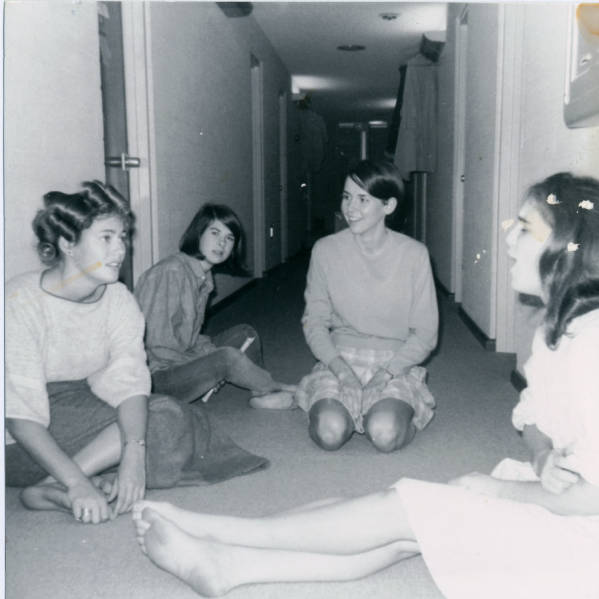
New Acquisition: Soviet-Era Posters
Special Collections has received 24 Soviet era posters from a Claremont Graduate University professor, excellent examples of political imagery and message in the post WWII period in eastern Europe. We’ve digitized them, and the collection will be available in the Claremont Colleges Digital Library in the fall.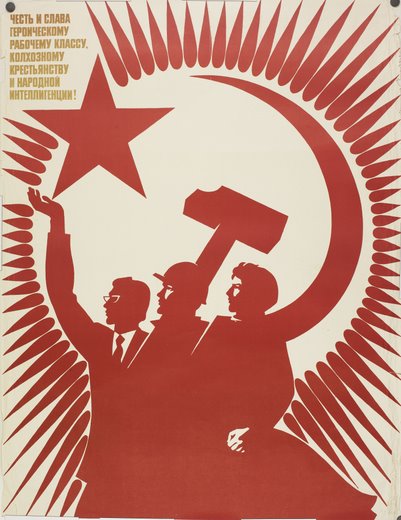
W. D. Macray’s Life of Milton
Like many special collections, we have had a formidable backlog of uncatalogued books and unprocessed collections, and we’ve made great strides over the past several years in providing access to many of these hidden collections. As we move through the backlog, we find all kinds of treasures and rarities; once in a while we find something endearing and even eccentric.
A particular example of the endearing and eccentric has been found among the rare book collection of Dr. Walter Lindley and his son Francis Haynes Lindley: W. D. Macray’s heavily annotated copy of Some Account of the Life and Writings of John Milton by H. J. Todd (London, 1826). Macray wrote his notes on little scraps of paper and pasted them into the volume; he also penciled in notes on the margins of the book, and pasted in clippings and writings inside the book covers. Here’s an example: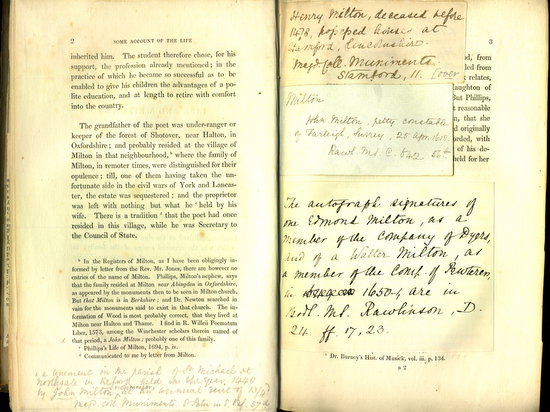
Call Number Hon Spcl Lindley PR 3581 T6 1826
William Dunn Macray was a British librarian, historian, and bibliographer during the 19th century. Among his contributions to scholarship are several volumes of catalogs of private and university library collections, especially at Oxford colleges, and Annals of the Bodleian Library. On the flyleaf of the Life of Milton is a note written by Macray from 1846, when he was a student attending Magdalen College.
The Francis Haynes Lindley Memorial Collection was donated to Honnold Library by Walter Lindley and F. Haynes Lindley, Jr. in memory of their father, Francis Haynes Lindley. The 3,000 volume collection was begun by Dr. Walter Lindley, physician and civic leader in early 1900s Los Angeles, who had a life-long passion for books and reading, especially Shakespeare, which he passed to his son, Francis Haynes Lindley. The Lindley Collection covers a wide range of subjects including history, literature, poetry, drama, and travel. It is particularly strong in Shakespeare, Milton, dramatists through Sheridan, Samuel Johnson, and Sir Richard Burton.
Protestant Hymnal Printed in India
Believed to be the first Protestant hymnal printed in India is Amos Sutton’s, Hymns Especially Designed for Divine Worship Public, Social, and Private, Selected from Various Authors (Cuttack, Calcutta, Orissa Mission Press, 1840).
A copy of this scarce hymnal can be found in the Robert Guy McCutchan Collection in Special Collections, Honnold Library. Call number BV 510.O7 S88 1840.
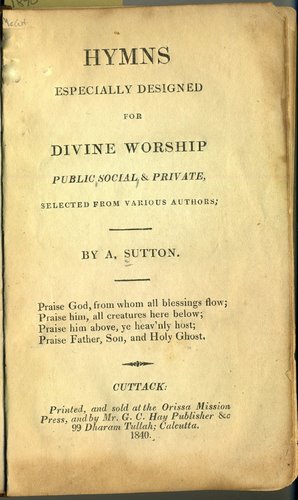
Title Page of Sutton’s Hymns
This small note about its printing is found at the end of the Preface:
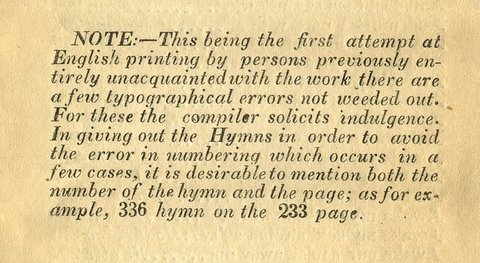
The Orissa Province had been under the control of Britain since the late 18th century. In the 19th century, control was transferred from the East India Company to the Crown. The Orissa Mission was the site of significant development when business and political enterprise brought with it the establishment of schools and missions, and by the 1860s, it was a center for printing and publishing of newspapers and journals.
Amos Sutton arrived in India around 1825 and established himself at Cattuck in the Orissa Province where he translated hymns into the Oriya language, among other activities. His hymnal from 1840 is printed in English and comprises texts edited by Sutton from various sources; in his Preface, Sutton admits he edited some source texts dramatically.
For many years Dean of the School of Music at DePauw University, McCutchan was editor of the 1935 edition of the Methodist hymnal. The McCutchan Collection is particularly rich in Methodist hymnals and psalters including early editions by John Wesley, but it also contains hymns that have been sung in America by all denominations.
The collection dates from the early 17th century to the present, and the majority are American publications. The range is broader than hymnology: song books of temperance societies, Grange and fraternal organizations, and political parties; Civil War songs; and children’s song books are to be found among the titles.
Scenes from Rural China–Papermaking
From the papers of Marjorie Rankin Steurt held in Special Collections are numerous photographs taken by Mrs. Steurt while she served as a missionary and educator in China during the 1920s-1930s. Her diaries, too, are full of keen descriptions of the everyday lives of the Chinese people to whom she was deeply devoted. This photo of a man working with newly handmade paper is just one example.
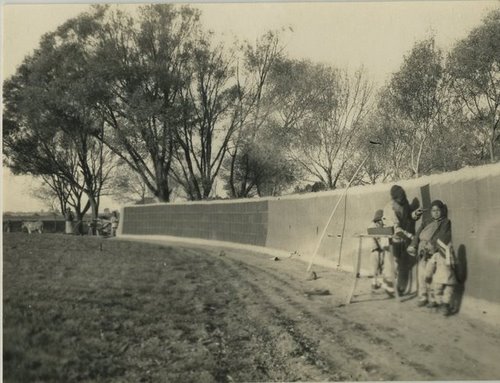
Marjorie Rankin was born in Pennsylvania in 1888 to evangelical Protestant parents. She received a BA from Mt. Holyoke College in 1911 and later received an MA and PhD from Columbia University. Her first teaching position was in 1911 in a rural school for African Americans in Alabama. In 1912, she traveled to China as a missionary and teacher at the Christian college in Weihsien. From 1926-1927 she moved on to Cheeloo University in Tsinanfu, the capital of Shentung. In 1929 she became the director of an experimental school in Nankai, in Tientsin; when the university was destroyed by the Japanese in 1932 , she moved back to the United States and taught psychology at a college in New York for many years.
Mrs. Steurt was interviewed in 1970 about her life and career in China, and the transcript of her oral history is available to read in Special Collections: Call number XC 14 OR24 ST46. She gave to us her papers shortly thereafter. The finding aid to her papers, and those of other American missionaries in China that are in our Special Collections, can be found on the web at the Online Archive of California. http://tinyurl.com/34euqpe
New Acquisition–20th Century Chinese Posters
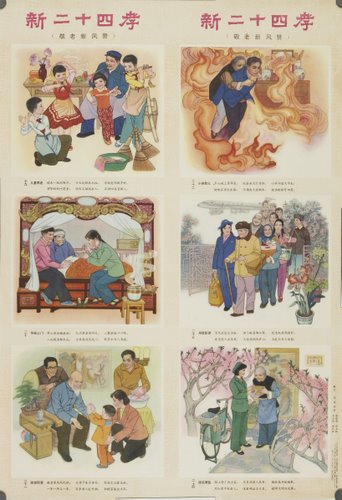
Special Collections recently received a gift of approximately 45 original posters and prints from mid-century China. They will be processed and available for study by September 2010. We’ve had them digitized for the Claremont Colleges Digital Library, debut date to be announced.